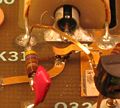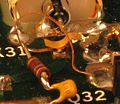7T11: Difference between revisions
(add picture) |
No edit summary |
||
| Line 8: | Line 8: | ||
Due its sampling principle (so called undersampling) it can only be used on | Due its sampling principle (so called undersampling) it can only be used on | ||
repetitive signals and samples are always taken from signal portions delayed | |||
from the trigger event. This delay is adjustable on the front panel to select | from the trigger event. This delay is adjustable on the front panel to select | ||
the portion of interest. At the three lowest sweep ranges the 7T11 changes | the portion of interest. At the three lowest sweep ranges the 7T11 changes | ||
| Line 20: | Line 20: | ||
locks to the signal and generates an internal pre-trigger. | locks to the signal and generates an internal pre-trigger. | ||
If only bandwidths of up to 3GHz are needed, single events can be observed | If only bandwidths of up to 3GHz are needed, single events can be observed | ||
directly be using the [[7M11]] analog delay line plug-in. | directly be using the [[7M11]] analog delay line plug-in. [This should be | ||
clarified. It seems to imply that a single event can be plotted using a | |||
7T11.] | |||
Manual or external sweep is possible to connect a slow pen plotter. | Manual or external sweep is possible to connect a slow pen plotter. | ||
Revision as of 18:20, 25 February 2012

The 7T11 is a time base plug-in for the 7000 mainframe family. It was specially designed to build a sampling oscilloscope configuration together with the 7S11 including one of the sampling heads. The fastest sweep is 10ps/div and lowest jitter is 10ps, depending on actual settings.
Trigger bandwidth is 500MHz from internal and 1 GHz from external trigger sources. Additionally there is an internal 200MHz oscillator with analog trigger count down, which can be synchronized from external signals up to 14GHz.
Due its sampling principle (so called undersampling) it can only be used on repetitive signals and samples are always taken from signal portions delayed from the trigger event. This delay is adjustable on the front panel to select the portion of interest. At the three lowest sweep ranges the 7T11 changes from the undersampling principles to real-time sampling.
Due the high bandwidth of the sampling heads, there is no Y-delay-line in the heads, so the 7T11 needs an external pre-trigger, if there are random, high jitter signals or if the original signal triggered onto shall be observed. In the special case of a periodic signal with low jitter, a random sampling mode can be used, so that the signal triggered on can be observed. In this case an internal PLL locks to the signal and generates an internal pre-trigger. If only bandwidths of up to 3GHz are needed, single events can be observed directly be using the 7M11 analog delay line plug-in. [This should be clarified. It seems to imply that a single event can be plotted using a 7T11.]
Manual or external sweep is possible to connect a slow pen plotter.
Because the 7T11 and 7S11 have direct interconnections side by side, they work also in slow mainframes. The 7T11 supports up to two 7S11 and allows also x-y operation.
The 7T11 uses a BSM connector for pulse output on the front panel.
- Tektronix 7T11A Manual (PDF)
- Tektronix 7T11 Manual (OCR, PDF)
- Tektronix 7T11A Manual (OCR, PDF)
- Dave Partridge's Report on Converting a Tektronix 7T11 to a 7T11A
-
-
Right view
-
Left view
-
noisy 8GHz taken with 7T11,7S11,S6,7904
-
Trigger board in a 7T11
-
Tunnel Diode CR28 in a 7T11
-
Tunnel Diode CR28 in a 7T11A





